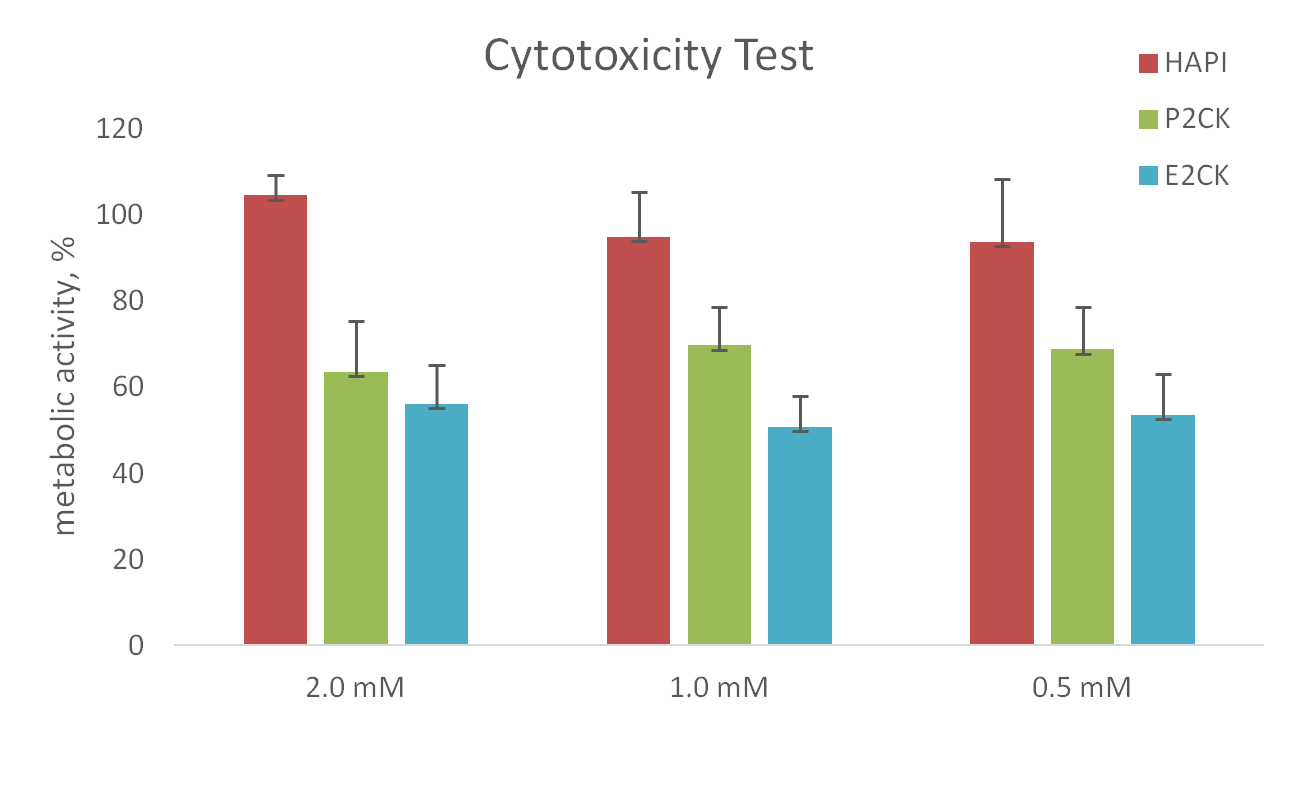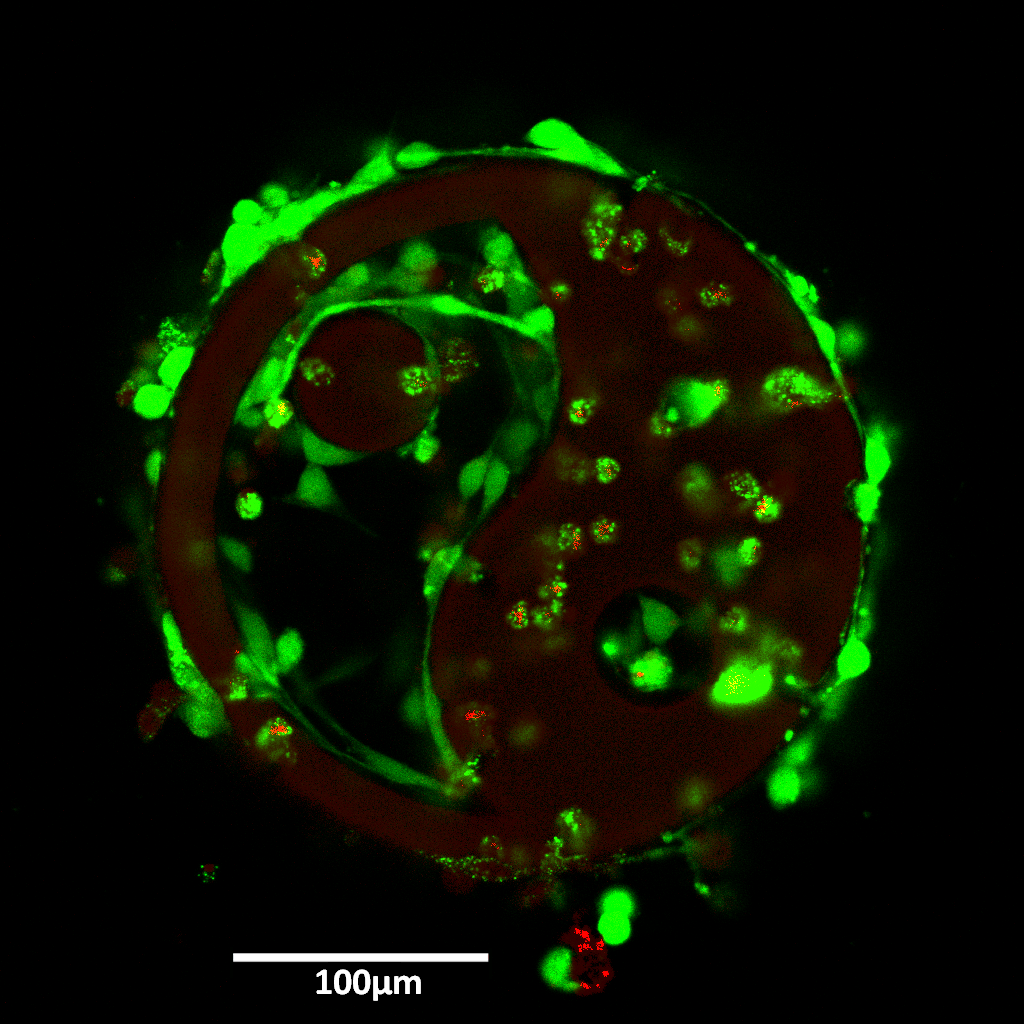Introduction: Two-photon polymerization (2PP) technique enables free-form manufacturing with a resolution in the sub-micrometer range. It has been employed to produce precise 3D tissue engineering scaffolds[1]. 2D substrates used in traditional cell culture systems can lead to significant differences in structure, function or physiology compared to living tissue, whereas 3D scaffolds allow a more accurate reconstruction of the cells' natural environment. Especially attractive is the option of fabrication of hydrogels with embedded cells[2].
While specialized water-soluble two photon initiators (2PIs) have been developed[3], there is still a need for novel initiators with improved cytocompatibility. The present work aims at this via binding 2PI molecules to hyaluronan as a polymeric backbone, thus hindering diffusion through the cell membrane and restricting the 2PI to the extracellular matrix.
Materials and Methods: An efficient 2PI chromophore based on dibenzylidene-cyclohexanone was prepared via aldol condensation and equipped with suitable amino linker groups in a 4-step synthesis. Subsequent covalent binding to hyaluronan via carbonyldiimidazole-mediated amidation lead to hyaluronic acid-bound photoinitiators (HAPIs) of varying chain lengths and degrees of substitution.
Besides comprehensive characterization of HAPI and all intermediate compounds using various techniques (1H- and 13C-NMR, HR-MS, SEC, UV/Vis- and 2PA-spectroscopy,..), the cytotoxicity was evaluated and compared to 2PI references in a PrestoBlue assay.
Finally, HAPI was tested in its designated application by 2PP cross-linking of methacrylated gelatin to encapsulate live MC3T3 cells, whose viability was assayed by live/dead-staining and laser scanning microscopy imaging.
Results and Discussion: Comparison of metabolic activity of MC3TC cells exposed to either HAPI or the water-soluble small-molecule 2PI references[2] P2CK and E2CK demonstrated a significantly reduced cytotoxicity for the polymer-bound 2PI, as illustrated in Figure 1.

The first generation HAPIs based on 1.6 MDa hyaluronan showed acceptable water solubility on their own, but were incompatible with cross-linkable pre-polymers as precipitation occurred. Using degraded hyaluronan with a chain length of 56 kDa and methyl-β-cyclodextrin to aid solvation, 2PP cross-linked 3D hydrogel structures were successfully obtained. MC3T3 cells encapsulated in the gelatin-based hydrogel were kept viable for several days, and proliferated in the cavities of the structure (see Figure 2).

Conclusion: A 2PI precursor was developed and covalently linked to hyaluronan to hinder diffusion from the extracellular matrix into cells, thus limiting cytotoxicity and photodamage by the obtained HAPI.
Cytotoxicity testing proved superior biocompatibility of HAPI compared to reference water-soluble 2PIs. 2PP of 3D hydrogel structures was achieved by cross-linking methacrylated gelatin with HAPI. MC3T3 cells were successfully encapsulated and viable cells were observed over a period of 5 days using a live/dead-staining assay, indicating a low phototoxicity of HAPI.
Austrian Science Funds (FWF, Project P27555); European Research Council (Starting Grant-307701, A.O.)
References:
[1] Ovsianikov, A., Mironov, V., Stampf, J. and Liska, R., Engineering 3D cell-culture matrices: multiphoton processing technologies for biological and tissue engineering applications. Expert Rev. Med. Devices, 2012. 9(6): p. 613-633.
[2] X.H. Qin, A. Ovsianikov, J. Stampfl, R. Liska, Additive manufacturing of photosensitive hydrogels for tissue engineering applications. BioNanoMaterials, 15 (2014), 3-4; S. 49 - 70.
[3] Li, Z., Torgersen, J., Ajami, A., Muehleder, S., Qin, X., Husinsky, W., Holnthoner, W., Ovsianikov, A., Stampfl, J. and Liska, R., Initiation efficiency and cytotoxicity of novel water-soluble two-photon photoinitiators for direct 3D microfabrication of hydrogels. RSC Adv., 2013. 3(36): p. 15939-15946.